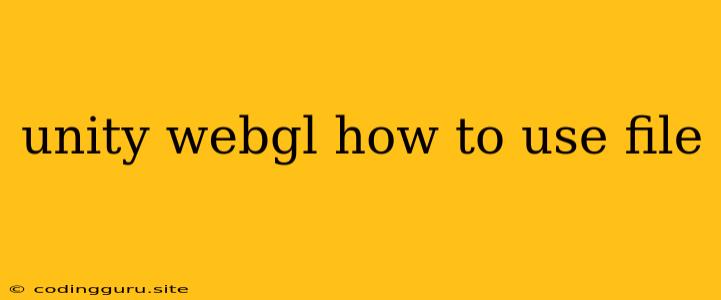Unity WebGL: How to Use Files
Unity WebGL is a powerful platform for bringing interactive 3D experiences to the web. One of the key aspects of creating engaging experiences is the ability to utilize files, such as images, audio, or data, within your WebGL build. This guide will provide a comprehensive overview of how to use files in your Unity WebGL projects.
Understanding the Limitations
Before we delve into the methods, it's crucial to understand the limitations of file handling in Unity WebGL:
- Security Restrictions: WebGL runs within a sandbox environment, meaning it has limited access to the user's file system. This means you cannot directly read or write files on the user's computer.
- Cross-Origin Policies: WebGL builds adhere to strict cross-origin policies. This means you can only load files from the same origin (domain, protocol, and port) as your WebGL build.
Methods for Utilizing Files
Despite these limitations, there are several effective methods to work with files in your Unity WebGL projects:
1. Embedding Files Directly in Your Build:
This is the most common and straightforward approach. You can embed your files directly into your Unity project, which will be bundled into your WebGL build.
- Advantages: Simple, efficient, and secure.
- Disadvantages: Requires you to include all files in your project, limiting flexibility for dynamically changing content.
Example:
Let's say you want to load an image directly from your build. You can create a Texture2D object in Unity, assign the image file to it, and then use it in your code:
// Assign the image in the Inspector
public Texture2D myImage;
void Start()
{
// Access the image and use it, for example, in a UI element
GetComponent().texture = myImage;
}
2. Using the WWW Class:
The WWW class in Unity provides a way to load files from external sources, including web servers.
- Advantages: Flexible for loading dynamic content from remote servers.
- Disadvantages: Requires a server to host the files, and loading time can be affected by network latency.
Example:
This example shows how to load a JSON file from a web server using WWW:
using UnityEngine;
using UnityEngine.Networking;
public class LoadJSON : MonoBehaviour
{
public string jsonURL = "https://example.com/my_data.json";
void Start()
{
StartCoroutine(LoadJSONFile());
}
IEnumerator LoadJSONFile()
{
UnityWebRequest request = UnityWebRequest.Get(jsonURL);
yield return request.SendWebRequest();
if (request.result == UnityWebRequest.Result.Success)
{
string jsonText = request.downloadHandler.text;
// Process the JSON data here
Debug.Log("JSON Data: " + jsonText);
}
else
{
Debug.LogError("Error: " + request.error);
}
}
}
3. User Input and File API:
While direct file access is restricted, you can leverage the browser's File API to allow users to select files from their local machine.
- Advantages: Allows users to interact with their own files.
- Disadvantages: Requires user interaction, and you have limited control over the uploaded files.
Example:
This example shows how to use the File API to allow a user to select a file for upload:
4. WebSockets for Real-time Communication:
WebSockets provide a bi-directional communication channel between your WebGL build and a server. This enables real-time file transfer, including uploading and downloading files.
- Advantages: Enables real-time file transfer and communication with the server.
- Disadvantages: Requires a server implementation to handle the WebSocket connection and file management.
Example:
This example illustrates the basic concept of using WebSockets for file transfer:
using UnityEngine;
using UnityEngine.Networking;
public class WebSocketFileTransfer : MonoBehaviour
{
// URL of the WebSocket server
public string websocketURL = "ws://example.com/file-transfer";
private WebSocket ws;
void Start()
{
ws = new WebSocket(websocketURL);
ws.OnOpen += OnWebSocketOpen;
ws.OnError += OnWebSocketError;
ws.OnMessage += OnWebSocketMessage;
ws.Connect();
}
private void OnWebSocketOpen(WebSocket ws)
{
Debug.Log("WebSocket connection established.");
}
private void OnWebSocketError(WebSocket ws, string error)
{
Debug.LogError("WebSocket error: " + error);
}
private void OnWebSocketMessage(WebSocket ws, string message)
{
// Process the received message
Debug.Log("WebSocket message received: " + message);
}
// ... (Implementation for sending and receiving file data) ...
}
Choosing the Right Method
The choice of method depends on your specific needs and the nature of your project:
- Embedded Files: Suitable for static assets that don't need to change often.
WWWClass: Ideal for dynamic content loaded from a server.File API: Provides user interaction for file selection.- WebSockets: Perfect for real-time file transfer and communication.
Best Practices
- Minimize File Size: Optimize images, audio, and other files to reduce loading times.
- Caching: Utilize browser caching to improve performance by storing files locally.
- Error Handling: Implement robust error handling mechanisms to gracefully handle file loading errors.
- Security: Always validate user input and follow security best practices when dealing with files.
Conclusion
Understanding how to use files in Unity WebGL is essential for building rich and interactive web experiences. By choosing the appropriate method based on your project's requirements, optimizing file size, and adhering to security best practices, you can effectively leverage files to enhance your WebGL applications.
